 This week the Memphis Belle came home to a place she’d never been before. And the Belle has been a lot of places. She was born in Seattle, Washington, on July 2, 1942. She flew to England in September and completed her first bombing mission over Europe in November. By May of 1943, she had completed her 25th mission and was sent “home”. She then toured the United States promoting War Bonds. After the war, she spent a little time in an Oklahoma airplane graveyard then a lot of time at various locations in Memphis, Tennessee. Since 2005 she’s been undergoing major restoration in Dayton, Ohio, and on Wednesday she was moved to the National Museum of the US Air Force. On Thursday, the exhibit was officially opened to the general public. That’s me.
This week the Memphis Belle came home to a place she’d never been before. And the Belle has been a lot of places. She was born in Seattle, Washington, on July 2, 1942. She flew to England in September and completed her first bombing mission over Europe in November. By May of 1943, she had completed her 25th mission and was sent “home”. She then toured the United States promoting War Bonds. After the war, she spent a little time in an Oklahoma airplane graveyard then a lot of time at various locations in Memphis, Tennessee. Since 2005 she’s been undergoing major restoration in Dayton, Ohio, and on Wednesday she was moved to the National Museum of the US Air Force. On Thursday, the exhibit was officially opened to the general public. That’s me.
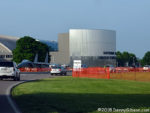
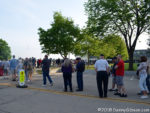 I arrived about an hour before the scheduled ceremony and was happy to see that traffic was not as bad as I had feared. There were plenty of people there, though. By the time I made it through the line and security, only about a third of that one hour wait remained.
I arrived about an hour before the scheduled ceremony and was happy to see that traffic was not as bad as I had feared. There were plenty of people there, though. By the time I made it through the line and security, only about a third of that one hour wait remained.
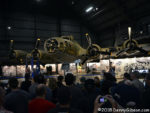
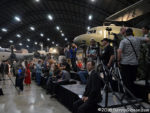
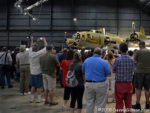 My first view of the restored airplane was somewhat obscured by some of those people who had been in line in front of me. I got a reasonably clear view by heading to the back where the media risers were.
My first view of the restored airplane was somewhat obscured by some of those people who had been in line in front of me. I got a reasonably clear view by heading to the back where the media risers were.
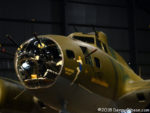 The Memphis Belle is often referred to as the first B-17 to complete 25 bombing missions but that honor actually belongs to Hell’s Angels which accomplished the feat about a week before the Belle. But the Memphis Belle was the first to return to the States. It seems likely the the romance behind the name had a lot to do with the selection. Memphis, Tennessee, was the home town of Margaret Polk who was the fiance of Robert Morgan, the plane’s pilot. Although Margaret broke off the engagement before the war ended, I don’t doubt that it helped sell more than a few war bonds.
The Memphis Belle is often referred to as the first B-17 to complete 25 bombing missions but that honor actually belongs to Hell’s Angels which accomplished the feat about a week before the Belle. But the Memphis Belle was the first to return to the States. It seems likely the the romance behind the name had a lot to do with the selection. Memphis, Tennessee, was the home town of Margaret Polk who was the fiance of Robert Morgan, the plane’s pilot. Although Margaret broke off the engagement before the war ended, I don’t doubt that it helped sell more than a few war bonds.
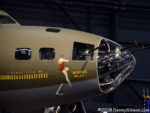 At war’s end, the Belle was designated surplus. In 1946, the city of Memphis bought her for $350 from an airplane graveyard near Altus, Oklahoma. They didn’t spend much more on her for a long time. She was initially parked outside at the Memphis Municipal Airport. In 1950, she was moved to the National Guard Armory and placed — still outside — on a concrete pedestal. In 1987, helped along by some noise from Air Force people, a covered pavilion was built for the plane on Memphis’ Mud Island. It was here I first saw her in 1990 and it seems like I should have some pictures around but a Friday afternoon search came up empty. The plane was moved to a Navy hangar in Millington in 2002 where the deterioration was reined in and restoration begun before the 2005 move to Dayton.
At war’s end, the Belle was designated surplus. In 1946, the city of Memphis bought her for $350 from an airplane graveyard near Altus, Oklahoma. They didn’t spend much more on her for a long time. She was initially parked outside at the Memphis Municipal Airport. In 1950, she was moved to the National Guard Armory and placed — still outside — on a concrete pedestal. In 1987, helped along by some noise from Air Force people, a covered pavilion was built for the plane on Memphis’ Mud Island. It was here I first saw her in 1990 and it seems like I should have some pictures around but a Friday afternoon search came up empty. The plane was moved to a Navy hangar in Millington in 2002 where the deterioration was reined in and restoration begun before the 2005 move to Dayton.
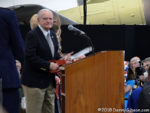
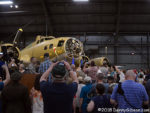 A formal unveiling had taken place the night before for the family of crew members and other VIPs. Today’s ceremony consisted of just a couple of short speeches and a symbolic ribbon cutting. I did not have much of a view of the ribbon cutting although it didn’t really matter. The participants’ names had been announced but I could not have put a single name with a face. The ribbon cutting was the signal to remove the ropes that had blocked the plane and the many displays around it. It quickly became apparent that this was not going the be a good time to leisurely read placards and study pictures.
A formal unveiling had taken place the night before for the family of crew members and other VIPs. Today’s ceremony consisted of just a couple of short speeches and a symbolic ribbon cutting. I did not have much of a view of the ribbon cutting although it didn’t really matter. The participants’ names had been announced but I could not have put a single name with a face. The ribbon cutting was the signal to remove the ropes that had blocked the plane and the many displays around it. It quickly became apparent that this was not going the be a good time to leisurely read placards and study pictures.
 It was, however, a good time to visit the new building that opened last year. On the way I paused to snap a picture of the B-2 and a man walking a few steps behind me caught up with me. “It won’t show up”, he said. I was too slow to get it but must have looked sufficiently quizzical for him to spare me the embarrassment of asking a truly dumb question. “Too stealthy”, he explained.
It was, however, a good time to visit the new building that opened last year. On the way I paused to snap a picture of the B-2 and a man walking a few steps behind me caught up with me. “It won’t show up”, he said. I was too slow to get it but must have looked sufficiently quizzical for him to spare me the embarrassment of asking a truly dumb question. “Too stealthy”, he explained.
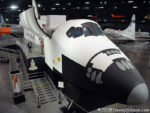 The closest thing to a space shuttle at the museum sits at the entrance to the new building. It is one of three NASA Crew Compartment Trainers. This is CCT-1 which was used in training more than 300 shuttle bound astronauts. Mock structures surround it so that it appears to be part of an actual shuttle.
The closest thing to a space shuttle at the museum sits at the entrance to the new building. It is one of three NASA Crew Compartment Trainers. This is CCT-1 which was used in training more than 300 shuttle bound astronauts. Mock structures surround it so that it appears to be part of an actual shuttle.
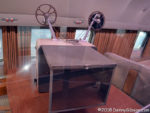
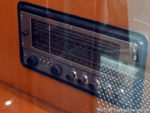
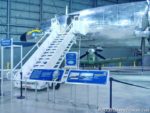 A good portion of the new building is used to display the presidential aircraft that used to be in a building actually on the Wright-Patterson Air Force Base with a bus ride and additional security check required. I’ve seen them before but that didn’t keep me from walking through all of them again. Since I recently visited Ike’s birthplace, I picked his Columbine III to represent the exhibit and to show 1950s state-of-the-art audiovisual gear.
A good portion of the new building is used to display the presidential aircraft that used to be in a building actually on the Wright-Patterson Air Force Base with a bus ride and additional security check required. I’ve seen them before but that didn’t keep me from walking through all of them again. Since I recently visited Ike’s birthplace, I picked his Columbine III to represent the exhibit and to show 1950s state-of-the-art audiovisual gear.
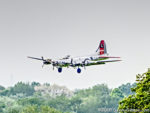
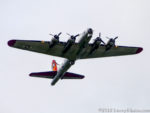
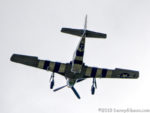 Weather had cancelled yesterday’s planned landing of other World War II vintage aircraft. Earlier, as I stood in that long line getting in, it was announced that they would be landing at 11:00 today. I misjudged the time but did get outside just in time to see the first B-17 approach the field through an opening in the trees. I caught the second one overhead, and thought I’d positioned myself for a better view of the landing but found out I’d positioned myself to pretty much miss seeing it at all. I had read that three B-17s were to be flying about this weekend , but I only saw the two. There were, as advertised, several P-51 Mustangs (3rd picture) in the air.
Weather had cancelled yesterday’s planned landing of other World War II vintage aircraft. Earlier, as I stood in that long line getting in, it was announced that they would be landing at 11:00 today. I misjudged the time but did get outside just in time to see the first B-17 approach the field through an opening in the trees. I caught the second one overhead, and thought I’d positioned myself for a better view of the landing but found out I’d positioned myself to pretty much miss seeing it at all. I had read that three B-17s were to be flying about this weekend , but I only saw the two. There were, as advertised, several P-51 Mustangs (3rd picture) in the air.
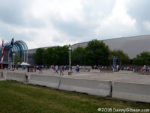 One reason I nearly missed the landings completely was that I tried to make sure there was nothing I needed to go back inside for. The decision was reinforced by seeing the line outside. It was just about as long as it had been when I arrived and now the museum was nearly full. I promised myself I’d return before long to read the placards and headed to my car.
One reason I nearly missed the landings completely was that I tried to make sure there was nothing I needed to go back inside for. The decision was reinforced by seeing the line outside. It was just about as long as it had been when I arrived and now the museum was nearly full. I promised myself I’d return before long to read the placards and headed to my car.
